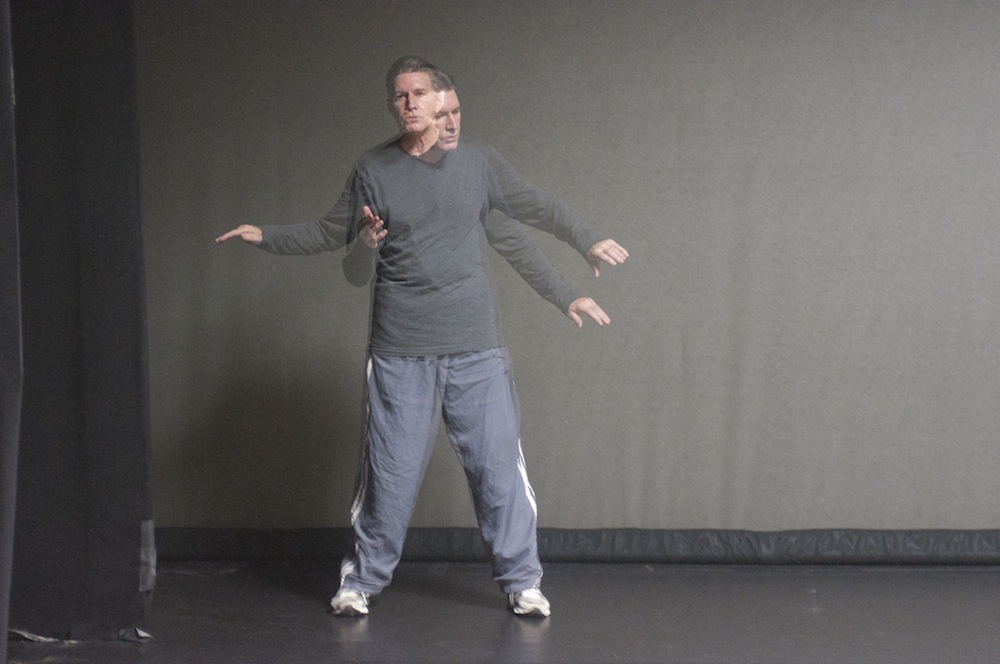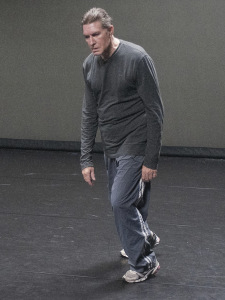Storytelling, Masculinity, and What “It” Is
Storytelling, Masculinity, and What “It” Is
Farrell Dyde Offers a New Show at The Barn
Farrell Dyde is a dancer and choreographer with a large body of documented work. In fact, you can search his name on YouTube and come up with dozens of videos reaching back to the 1970s.
On November 21 and 22, at The Barn, Dyde is celebrating 40 years of the Farrell Dyde Dance Theatre with a new program of solo work entitled Dat is Het.
In talking with Dyde, you quickly get the impression that his inspiration comes from a wide range of sources. In the course of a conversation, you hear expected names like Merce Cunningham or names from the 1960s Judson Dance Theater. Film dancers like Fred Astaire and Gene Kelly are not completely out of left field, but then names like Red Skelton and Danny Kaye pop up. He explains it matter of factly. “I’m influenced by all the television I’ve watched and all the films I’ve seen,” he says. “That’s our modern culture, we’re influenced by all these images and things that we see. As performers, we absorb a lot of that.”
For a dancer, his approach for making work may surprise some people. “I do approach things from a narrative point of view rather than a purely musical point of view,” he says. “This is mostly true with my solo work because I approach it as an actor.” Taking on a character and telling his story via movement is not completely unique to Dyde, of course, but he seems particularly dedicated to storytelling as his primary thrust.
And then, he seems to be somewhat indifferent to whether or not people get precisely the story he’s telling. This current program is, in his mind, an evening of three different pieces, each telling the story of a different character. He acknowledges, however, that he cannot control the perceptions of his audience. “Since one person is performing all of them and it’s one evening the person viewing it could conceivably tie them together.” The narrative, then, is not so literal and obvious that broad interpretations are prohibited.
There is also the matter of the curious name for the program. Here he drew inspiration from a biography, Van Gogh: The Life, by Steven Naifeh and Gregory White Smith. In it, Van Gogh’s concern with the “it-ness” of his paintings was discussed and the Dutch phrase, “dat is het,” or “this is it,” is used. “It just struck me at that moment, and actually that moment was sort of the genesis of the concert.”
Part of what Dyde liked about the phrase was that it could mean different things when separated from Van Gogh’s context. It might mean “here is the thing,” or “here is the quality I’m looking for,” but it might also mean “this is the last time I’ll do this.” While vowing to never say never, Dyde admits he approaches each show with the thought that it could be his last, that he won’t take on another. More generally, however, he confesses, “Often times with titles of concerts, I just try to find something that might be intriguing to people while not necessarily revealing everything that it can be about.”
As for the particulars of this concert, it opens with In a Landscape, which features music by Eric Clapton and Brian Eno. Dyde reveals very little about this piece except to say that it is the most abstract work of the evening. He also offers this less than defining, yet intriguing, statement about the music: “I use the popular music to evoke nostalgia or ideas that might be in the memory of the person viewing it.”
The second piece, Notturno, featuring music by Steve Reich, Philip Glass, Harold Budd and Chopin, has more clarity. As the title suggests, the story takes place at night and the character Dyde is portraying is experiencing a series of emotions, somewhat akin to the stages of grief. He says, “I would say Notturno could be about a cop, a detective whose wife may have recently died or he may have gotten divorced.” Then, as if to demonstrate his willingness to interpret his own story, he says, “I mean, he could be a fireman, but I think he’s a detective.”
The final piece, Dat is Het, obviously lends it’s name to the whole evening and features music by the Ink Spots and Paul Lansky. “The last piece sort of wobbles back and forth between something spiritual and something comic, and the character is perhaps more identifiable,” Dyde says. “He’s probably a construction worker, but there’s probably a little Buster Keaton thrown in there, too.”
Dyde is dedicating this evening of dance to his father, who died last year. Dyde feels his father, a World War II veteran, exemplified the men of his generation, somewhat trapped by a particular model of manhood. As a man coming of age in the 1950s and ’60s, Dyde feels he inherited some of these traps and an exploration of “macho posturing,” (as his website calls it) runs through his solo work, right into this current concert.
“I started off as an athlete, playing baseball, football, basketball,” he says. “So I was inculcated in that whole jock mentality. There was a suppression, a repression of emotions. Those were things I had to break out of in order to become a dancer.” For Dyde, dance became a way of both exploring and dismantling some that “jock mentality,” particularly noting dance improvisation as a way to “…become more fluid in both my emotion as well as my motion.”
While exploring these themes, he’s committed to doing so honestly as he ages. “I’m 66 years old,” he says. “On the stage, I’m not going to try to portray somebody who’s 25 years old. I’m picking situations and characters or scenarios that are possible for me to perform physically and realistically, so what I’m doing is convincing.” He laughs softly. “I’m not going to be doing a lot of jumping.”
A final thing you may want to know before attending Dat Is Het is that there will be light food and drink included in the price of a ticket. There will be an intermission between each individual piece to give people time to socialize and snack, all of which is part of the aforementioned 40th anniversary celebration.
He quips, “For me it’s kind of a party interrupted by me performing.”
Neil Ellis Orts, a native Texan, is a writer and performer. He holds an M.A. in Interdisciplinary Arts from Columbia College Chicago. He occasionally produces his own performance work as Breath & Bone/Orts Performance. His novella, Cary and John, was published in the summer of 2014 and has a short story in the newly published anthology, Outer Voices, Inner Lives (both books available at Amazon.com).





Recent Comments